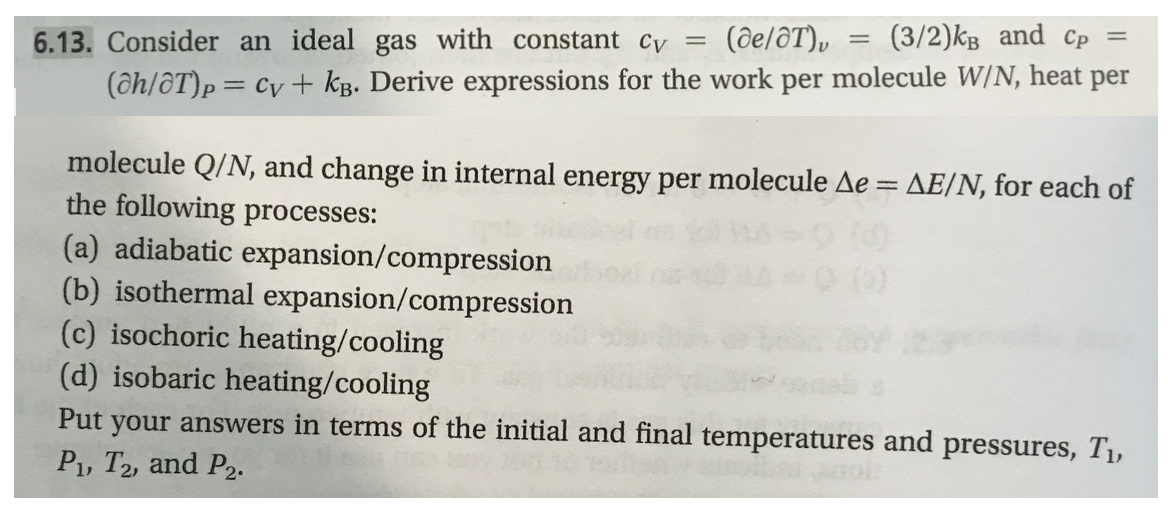(ce/OT), (3/2)% and cp - 6.13. Consider an ideal gas with constant cv (ah/aTh = cv-kB Derive expressions for the work per molecule WN heat per molecule Q/N, and change in internal energy per molecule he AE/N, for each of the following processes: (a) adiabatic expansion/compression (b) isothermal expansion/compression (c) isochoric heating/cooling (d) isobaric heating/cooling Put your answers in terms of the initial and final temperatures and pressures, T, P1, T2, and P2.
(ce/OT), (3/2)% and cp - 6.13. Consider an ideal gas with constant cv (ah/aTh = cv-kB Derive expressions for the work per molecule WN heat per molecule Q/N, and change in internal energy per molecule he AE/N, for each of the following processes: (a) adiabatic expansion/compression (b) isothermal expansion/compression (c) isochoric heating/cooling (d) isobaric heating/cooling Put your answers in terms of the initial and final temperatures and pressures, T, P1, T2, and P2.
Introduction to Chemical Engineering Thermodynamics
8th Edition
ISBN:9781259696527
Author:J.M. Smith Termodinamica en ingenieria quimica, Hendrick C Van Ness, Michael Abbott, Mark Swihart
Publisher:J.M. Smith Termodinamica en ingenieria quimica, Hendrick C Van Ness, Michael Abbott, Mark Swihart
Chapter1: Introduction
Section: Chapter Questions
Problem 1.1P
Related questions
Question
This problem is (6.13) from a book "

Transcribed Image Text:(ce/OT),
(3/2)%
and
cp
-
6.13. Consider an ideal gas with constant cv
(ah/aTh = cv-kB Derive expressions for the work per molecule WN heat per
molecule Q/N, and change in internal energy per molecule he AE/N, for each of
the following processes:
(a) adiabatic expansion/compression
(b) isothermal expansion/compression
(c) isochoric heating/cooling
(d) isobaric heating/cooling
Put your answers in terms of the initial and final temperatures and pressures, T,
P1, T2, and P2.
Expert Solution
This question has been solved!
Explore an expertly crafted, step-by-step solution for a thorough understanding of key concepts.
This is a popular solution!
Trending now
This is a popular solution!
Step by step
Solved in 6 steps with 6 images

Knowledge Booster
Learn more about
Need a deep-dive on the concept behind this application? Look no further. Learn more about this topic, chemical-engineering and related others by exploring similar questions and additional content below.Recommended textbooks for you

Introduction to Chemical Engineering Thermodynami…
Chemical Engineering
ISBN:
9781259696527
Author:
J.M. Smith Termodinamica en ingenieria quimica, Hendrick C Van Ness, Michael Abbott, Mark Swihart
Publisher:
McGraw-Hill Education

Elementary Principles of Chemical Processes, Bind…
Chemical Engineering
ISBN:
9781118431221
Author:
Richard M. Felder, Ronald W. Rousseau, Lisa G. Bullard
Publisher:
WILEY

Elements of Chemical Reaction Engineering (5th Ed…
Chemical Engineering
ISBN:
9780133887518
Author:
H. Scott Fogler
Publisher:
Prentice Hall

Introduction to Chemical Engineering Thermodynami…
Chemical Engineering
ISBN:
9781259696527
Author:
J.M. Smith Termodinamica en ingenieria quimica, Hendrick C Van Ness, Michael Abbott, Mark Swihart
Publisher:
McGraw-Hill Education

Elementary Principles of Chemical Processes, Bind…
Chemical Engineering
ISBN:
9781118431221
Author:
Richard M. Felder, Ronald W. Rousseau, Lisa G. Bullard
Publisher:
WILEY

Elements of Chemical Reaction Engineering (5th Ed…
Chemical Engineering
ISBN:
9780133887518
Author:
H. Scott Fogler
Publisher:
Prentice Hall


Industrial Plastics: Theory and Applications
Chemical Engineering
ISBN:
9781285061238
Author:
Lokensgard, Erik
Publisher:
Delmar Cengage Learning

Unit Operations of Chemical Engineering
Chemical Engineering
ISBN:
9780072848236
Author:
Warren McCabe, Julian C. Smith, Peter Harriott
Publisher:
McGraw-Hill Companies, The